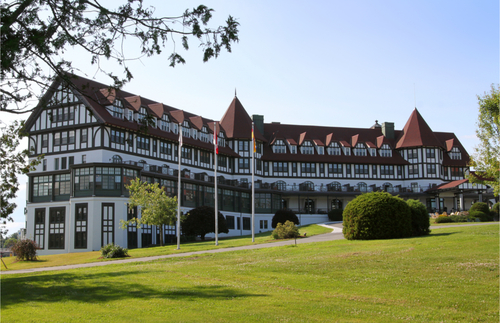
The lovely village of St. Andrews—or St. Andrews By-the-Sea, as the chamber of commerce persists in calling it—traces its roots back to the days of the Loyalists. After the American Revolution, New Englanders who had supported the British were made to feel unwelcome. They decamped first to Castine, Maine, which they presumed was safely on British soil. But it wasn’t; the St. Croix River was later determined to be the border between Canada and the United States. Forced to uproot again, the Loyalists dismantled their new homes, loaded the pieces aboard ships, and rebuilt them on the welcoming peninsula of St. Andrews, a short sail away. Some of these remarkably resilient saltbox houses still stand in town today.
In the late 19th century, this community emerged as a fashionable summer resort, as many of Canada’s affluent and well-connected built homes and gathered annually here for social activities. The Tudor-style Algonquin Hotel (pictured above, now known as The Algonquin Resort) was built on a low rise overlooking the town in 1889, and quickly became the town’s social hub and defining landmark.
St. Andrews is beautifully sited at the tip of a long, wedge-shaped peninsula. Thanks to its off-the-beaten-track location, the village hasn’t been spoiled much by modern development, and walking the wide, shady streets—especially those around the Algonquin—invokes a more genteel era. Some 250 homes around the village are more than a century old. A number of appealing boutiques and shops are spread along Water Street, which stretches for some distance along the town’s shoreline. It’s easy to grab a boat tour from the waterfront, and on Thursday mornings in summer, don’t miss the weekly farmer’s market on the waterfront. I definitely recommend this town if you’re seeking a tame, easy tourism dip into New Brunswick.
EXPLORING ST. ANDREWS
Look for A Guide to Historic St. Andrews, produced by the St. Andrews Civic Trust (or download a copy to your phone at www.standrewscivictrust.ca). With this in hand you’ll be able to launch your own mini history tour. To make it even easier, many of the private dwellings in St. Andrews feature plaques with information on their origins. Look in particular for the saltbox-style homes, some of which are thought to be the original Loyalist structures that traveled here by barge.
The village’s compact and handsome downtown flanks Water Street, a lengthy commercial street that parallels the bay. You’ll find low, understated commercial architecture, much of it from the turn of the 20th century, that encompasses a gamut of styles. Allow an hour or so for browsing at boutiques and art galleries. There’s also a mix of restaurants and inns.
At the west end, where Water Street becomes Joe’s Point Road, a stout wooden
blockhouse sits just off the water behind low grass-covered earthworks; it was built by townspeople during the War of 1812, when the British colonials anticipated a U.S. attack that never came. This structure is all that remains of the scattered fortifications created around town during that war. Across the street from the blockhouse, the peaceful
Centennial Gardens were established in 1967 to mark the centenary of Canadian confederation. The compact, tidy park has views of the bay and makes a pleasant spot for a picnic.
At its east end, Water Street curves around the open space of
Indian Point and the Kiwanis Oceanfront campground. The views of the bay are panoramic; somehow it’s even dramatic on foggy days, and swimming in these icy waters will earn you definite bragging rights. Look for history right at your feet when exploring the park’s rocky beaches: You’ll sometimes turn up worn and rounded flint and coral that has washed ashore. It’s not native, but rather imported—early traders sailing here from afar loaded up their holds with flint from Dover, England, and coral from the Caribbean to serve as ballast on their crossings. When they arrived, the ballast was just dumped offshore, and today it still churns up from the depths.
For a more protected swimming spot, wander down Acadia Drive, which runs downhill behind the Algonquin. You’ll come to popular Katy’s Cove, where floating docks form a sort of natural saltwater swimming pool along a lovely inlet. You’ll find a snack bar, a playground, and an affable sense of gracious ease here, and it’s a fine place for families to while away an afternoon. There’s a small fee.
Note: This information was accurate when it was published, but can change without notice. Please be sure to confirm all rates and details directly with the companies in question before planning your trip.









